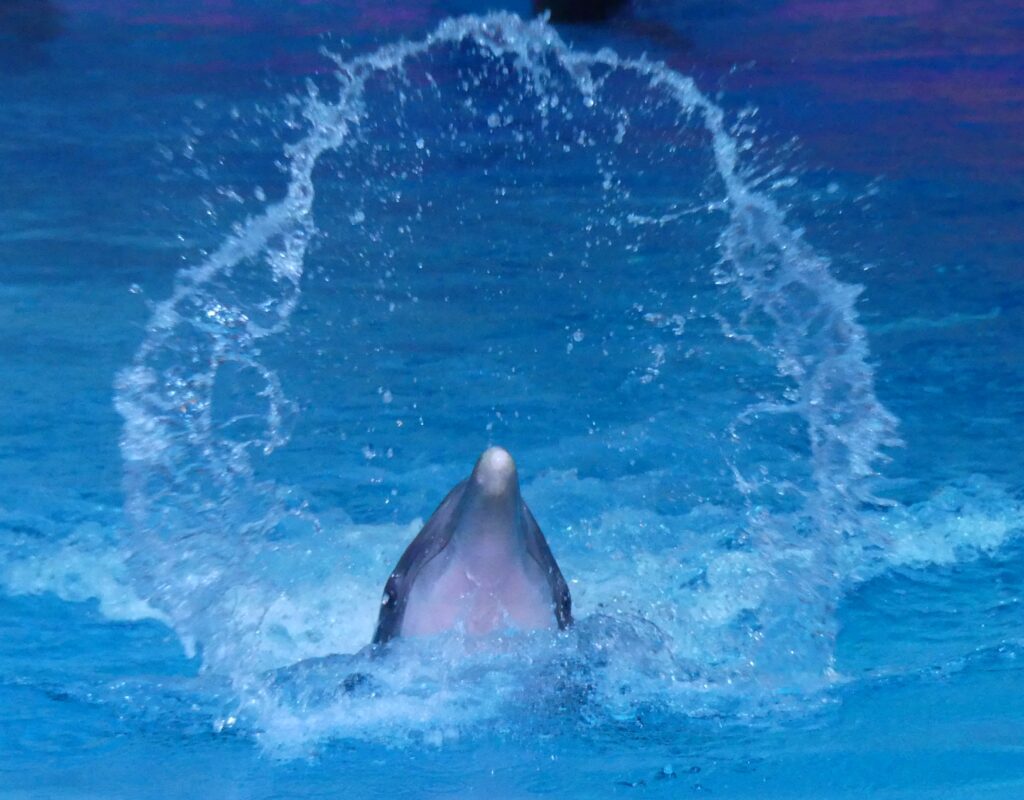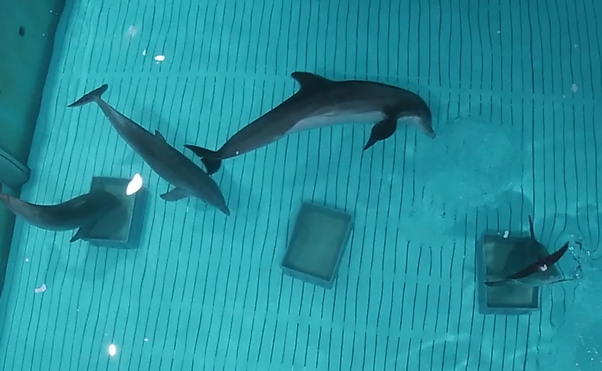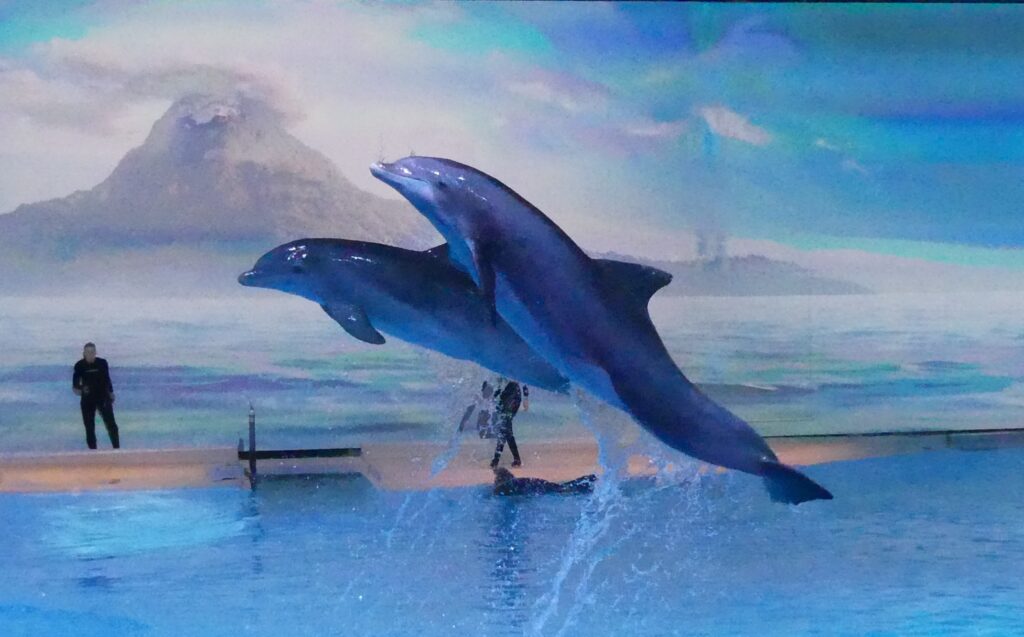The Meandering Hose
The data collected and observations made in this study showed several clear effects of the meandering hose on the sonar activity and behaviour of these dolphins. There was a high general interest in the hose, which was shown by the high overall sonar activity and high proportion of time spent observing and interacting with the hose in all sessions, regardless of which state it was in. From my observations I can also state that this interest stayed high throughout the sessions, sometimes continuing interacting with the hose until it was removed from the water at the end of a session.
The results showed that the total number of clicks, the number of click trains and the number of click trains with more than 100 clicks were positively affected by having the hose in an active state. However, for the proportion of click trains with more than 500 clicks out of the trains with more than 100 clicks there was a negative effect when the hose was in an active state.
The behavioural analysis showed similar trends to the significant results of the sound data. Significantly more time was spend observing, there was a higher frequency of high-speed pursuits, and a higher frequency of small bubbles that were produced from the blowhole in the active states of the hose compared to the inactive state. However, the number of times direct contact was made was the highest during the Off state.

It was not expected that for the 10 ms buzz ratio and the 2 ms buzz ratio the differences between the sessions in different states were not significant. Sonar buzzes are associated with prey capture in, among others, dolphins. That is why it was expected that when the hose was in an active state, thus simulating a prey fish, the two buzz ratios would be higher. A possible explanation for this can be in one of my personal observations. During Off sessions (inactive hose), I observed dolphins pushing the hose right at the tip of the hose with the hydrophone and push it in front of themselves. If the dolphins were echolocating at this time, the Inter Click Intervals (ICI) would be very small since their ‘target’ is right on their nose and result in buzzes.
Even when parameters showed clear, significant differences between states, there was still a high variation in the data with occasional outliers. This shows that, even if the state of the meandering hose significantly affected behaviour and sonar activity, there seem to be other factors at play when it comes to the dolphins’ behaviour. Some of these effects could be identified, albeit not backed up by statistics: the presence/absence of people walking around the pool, various social interactions between the dolphins like chasing, overall activity level of the dolphins on that day, and whether the netted gates between the pools were open or closed.
Dolphins are social animals, living in flexible fission-fusions societies and solitary dolphins often seek contact with humans. Besides this, in a dolphinarium humans are the suppliers of food, enrichment, training and frequent social interactions for the dolphins. This means that it is not surprising that human activity around the pools affects the activity around the hose enrichment.
The Shell Sand Boxes
The results show that for all observing behaviours both the presence of sonar targets and fish and the location of the boxes affect the duration of these behaviours. For the number of tail slaps done by the dolphins, neither the presence of sonar target nor the location of the box affected the frequency of this behaviour. However, both the frequency of bubble bursts and snapping were significantly positively affected by the presence of the sonar targets and fish and were not affected by the location of the box.

There was an unequal distribution of the position of the box with the sonar targets in it, this box was in the Left position 4 times, in the Middle position 1 time, and in the Right position 3 times. This explains why for some behavioural parameters, both the presence of the sonar targets and the position of the boxes influenced the frequency or duration of a parameter. If the presence of the sonar targets would have been the main factor that influenced the parameters the most, I would have expected to see the Middle box having the lowest values and the Left and Right box the highest values. However, this is not the case. For the parameters observing inside the box, observing above the box, observing outside of the box, and for the number of bubble bursts, the highest average of the parameters were in the Right box and the lowest averages in the Left box. While for the parameter snapping at conspecific, the Middle box had the highest average. This suggests that the location of the box influenced the frequency/duration of the behavioural parameters. A reason for this could be that the dolphins preferred to have more space while interacting with the boxes, since the Right box had the most open space around it compared to the Left and Middle boxes. It could also be that because the Right box was the closest to the channel to the Show Pool, it was the box that was the easiest to interact was since it was the nearest box when coming from the Show Pool.
From my observations and the results, it seems that the dolphins used brute force to find the fish instead of their sonar to detect the targets and associate the with the presence of fish. This is why, for future studies on these boxes, it is recommended to train the dolphins how to interact with this enrichment using their sonar.
Conclusion
In conclusion, the sonar-activated Meandering Hose had a clearly positive effect on overall sonar activity as well as on some exploratory and foraging- and hunting-like behaviours when in its active states. The fixed ejections of fish and the randomized ejections of fish and gelatine increased this effect even more, while just the ejection of gelatine strips did not increase this.
Despite the fact that the Shell Sand Boxes results are inconclusive, the enrichment is still considered successful. The interaction with the boxes was big and continued over long periods of time (up to 1.5 hours) and no dolphin seemed to have negative experiences with the boxes. To use the full potential of this enrichment in stimulating sonar activity, training would be necessary for the dolphins to be conditioned to detect these sonar targets. There is potential for this enrichment in its sonar-stimulation aspects if time is put into training the dolphins on how to interact with the enrichment
Both the enrichments show the potential of an increase in welfare by presenting them regularly to the dolphins.
